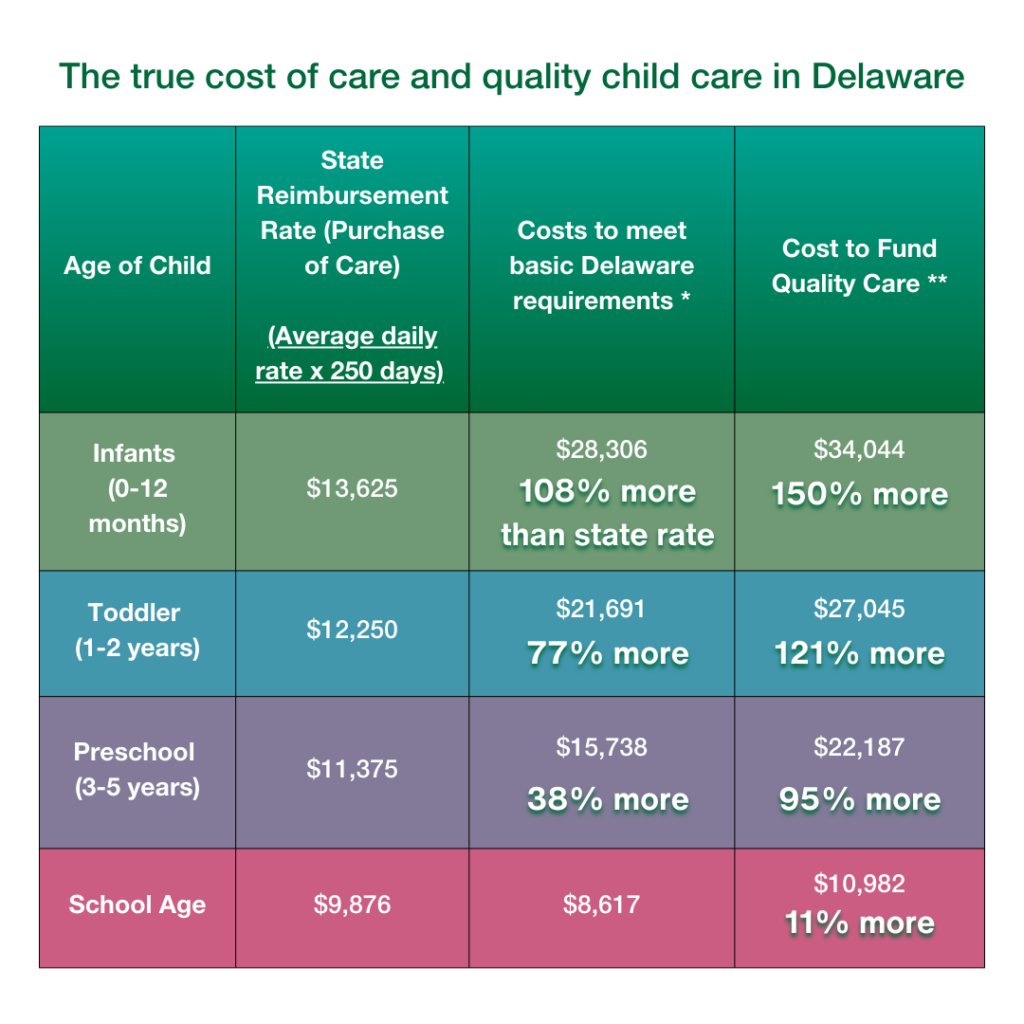True Cost of Quality Early Learning Exceeds State Rate Twice Over
-Delaware uses a broken system to fund Purchase of Care, the subsidy that covers child care tuition for low-income families. A new model estimates the state would need to invest 25-87 percent more just to pay for the basic legal requirements established by the state–and 87-143 percent more to fund quality, research-backed care.

In 2021, Delaware committed to changing how it calculates payment rates for Purchase of Care, the state subsidy that helps cover child care tuition for low-income families—moving from the market rate to the “cost of care” methodology. The Department of Health and Social Services (DHSS) and the Department of Education (DOE) have been approved by the Administration for Children and Families to conduct both methodologies, and the 2024 study has been released.
The state hired Prenatal to Five Fiscal Strategies again in 2024 to release a new report and estimator tools for child care centers and family child care.
Delaware joins 10 other states that have moved in this direction, with some using cost methodology to pay for early care and education in the state budget.
While the cost estimates do not guarantee a higher subsidy rate (and has not yet been funded), this tool provides much more transparency into the gap between what resources are truly needed and what is provided today.
What costs are considered and what do we mean by quality?
The tool calculates the total cost of child care—which is primarily driven by the educators in the classroom: their qualifications and salaries, and the size of the group of children and role/responsibilities. Typically in education, early childhood or K-12, personnel comprise about 70 percent of costs.
Research demonstrates that adults with professional qualifications (AA/BA degrees in child development or a related field) that lead smaller group sizes (three children at infant age group, up to 15 in preschool settings) are the most successful in supporting child development. Another key element is providing time for these professionals to plan, assess, engage with families—and partner with other experts like behavioral health consultants, occupational therapists, and curriculum coordinators.
The tool incorporates Delaware’s increasing minimum wage—which reaches $15/hour in January 2025, as well as an updated target compensation scale (to reflect 2024 values), which aligns early childhood workers’ pay with K-12 educator compensation (inflation adjusted from our 2022 scale), adds benefits, and provides a pathway (and incentives) for educators to reach higher levels of qualifications. Child care deserts and shortages are driven by low wages paid to educators—in many cases minimum wage—which are driven by low state reimbursement rates.[1]
What did the study find?
How much more is needed to truly fund the cost of care—and the cost of the quality care all children deserve? Delaware needs to invest:
- More per child – to reach the quality level recommended by Delaware experts (certified teachers, paid a fair wage, and with small group sizes), we need to invest 38-108 percent more per child just to pay for the basic legal requirements established by the state—and 95-150 percent more than what the state pays today to fund quality, researched-backed care. The study shows that programs cannot break even with any age group—which means they are going into debt or making compromises with their staff and programming.
Center Based Child Care ^– Annual Child Care Subsidy Reimbursement Rates Per Child (Purchase of Care)

Children with special needs are entitled to 5-8% more, a Delaware Working Group of experts recommended the state invest 20-50% more per child.
^ Family child care centers have similar costs, with estimates even lower in most cases.
* state requirements including licensing and minimum wage
** includes updated target salary scale, quality programming and family supports, and employee benefits and paid time off.
These findings are similar to the 2022 study, which found that Delaware was funding child care centers found that Delaware is underinvesting per child 12-86 percent more per child just to pay for the basic legal requirements established by the state–and 163-181 percent more (or 263-281 percent of what we pay today) to fund quality, researched-backed care.
Investments made in the last eight years have prevented these gaps from widening further. An additional $60 million in the state budget has helped keep up with rising costs and closed the geographical gap for Kent and Sussex counties. We are serving 2,600 more children; five years ago, Delaware was investing in about one in seven, and today we invest in one in five. We have made incremental progress and now look to make the transformational kind of progress children deserve.
- …In five times as many children as we are today (and based on their needs). Today, only 19 percent of children under age five are in a publicly funded early learning program—including Purchase of Care, Head Start, state pre-K (ECAP), and district special education programs. That means Delaware is not investing in at least 80 percent of children’s participation in educational programming before kindergarten. State funding for children with special needs is extremely limited, and additional funding for English learners is nonexistent.
The majority of a child’s brain is developed before kindergarten. How do our investments compare with K-12 education? In Delaware:
| Child Care (Purchase of Care) | K-12 | |
| Access | Covering less than 20% of children | All children |
| Per Child Per Year | $11,375-13,625 | $20,231 |
| Child’s Needs | 5-8% for children with special needs | 30-100% for children with special needs
9% for multilingual learners |
| Year | Year Round | 9 months |
| Day | 10-12 hours | 7 hours |
When federal, state and local dollars are taken into consideration, we spend $3.17 billion per year on K-12 education. But many costs are greater during birth to five: early learning requires more adults, more consumable goods (diapers, wipes, etc.), and more equipment (cribs, cots, separate sanitary toys) per child than in later years— so we expect costs to be larger per child.
What’s Next?
Consolidating governance of early learning investments would streamline funding and program standards to ensure they are as accessible to programs and families as possible—for example, combining funding for child care and pre-K programs into one agency, as 25 other states have done.
In order to fund these significant gaps, state revenue strategies may need to be explored, and a number of states are pursuing plans to support early childhood investments. For example, in the last five years, several states have increased revenue measures to pay for early learning, leveraging taxes on high-income individuals, payroll taxes, or general fund taxes like property and sales taxes, which are not in place in Delaware.
The cost of care study results present a huge opportunity and long-term movement—for Delaware to provide foundational services that all children deserve, that are the strongest investments government can make, and that most developed countries already provide.
MONTHLY Gap between the Cost of Basic Care (meeting state requirements) and Purchase of Care (state subsidy)
Programs offering school age (ages 5-12) programming can produce revenue; any other age group cannot cover costs

MONTHLY Gap between the Cost of Quality (meeting state funded preschool standards) and Purchase of Care (state subsidy)
Programs can break even for any age group

[1] Other costs in the tool include occupancy costs, insurance, taxes, food, classroom supplies, inclusion supports, reserves for capital costs, screening (developmental, vision, hearing). And, the tool assumes other sources of revenue for eligible programs, including CACFP food program.
(Not included are all the systemic supports needed to achieve these goals, including scholarships, professional development, quality improvement systems, monitoring, and more.)
Related Topics: child care licensing, child safety, Delaware education, Delaware legislature, early learning, early literacy, literacy, science of reading, teachers